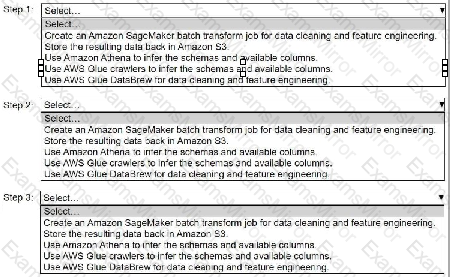Cyber Monday Special Limited Time 70% Discount Offer - Ends in 0d 00h 00m 00s - Coupon code = getmirror
Pass the Amazon Web Services AWS Certified Associate MLA-C01 Questions and answers with ExamsMirror
Exam MLA-C01 Premium Access
View all detail and faqs for the MLA-C01 exam
612 Students Passed
92% Average Score
95% Same Questions
An ML engineer needs to create data ingestion pipelines and ML model deployment pipelines on AWS. All the raw data is stored in Amazon S3 buckets.
Which solution will meet these requirements?
Case study
An ML engineer is developing a fraud detection model on AWS. The training dataset includes transaction logs, customer profiles, and tables from an on-premises MySQL database. The transaction logs and customer profiles are stored in Amazon S3.
The dataset has a class imbalance that affects the learning of the model's algorithm. Additionally, many of the features have interdependencies. The algorithm is not capturing all the desired underlying patterns in the data.
After the data is aggregated, the ML engineer must implement a solution to automatically detect anomalies in the data and to visualize the result.
Which solution will meet these requirements?
A company stores historical data in .csv files in Amazon S3. Only some of the rows and columns in the .csv files are populated. The columns are not labeled. An ML
engineer needs to prepare and store the data so that the company can use the data to train ML models.
Select and order the correct steps from the following list to perform this task. Each step should be selected one time or not at all. (Select and order three.)
• Create an Amazon SageMaker batch transform job for data cleaning and feature engineering.
• Store the resulting data back in Amazon S3.
• Use Amazon Athena to infer the schemas and available columns.
• Use AWS Glue crawlers to infer the schemas and available columns.
• Use AWS Glue DataBrew for data cleaning and feature engineering.

A company is planning to create several ML prediction models. The training data is stored in Amazon S3. The entire dataset is more than 5 ТВ in size and consists of CSV, JSON, Apache Parquet, and simple text files.
The data must be processed in several consecutive steps. The steps include complex manipulations that can take hours to finish running. Some of the processing involves natural language processing (NLP) transformations. The entire process must be automated.
Which solution will meet these requirements?
A company has a conversational AI assistant that sends requests through Amazon Bedrock to an Anthropic Claude large language model (LLM). Users report that when they ask similar questions multiple times, they sometimes receive different answers. An ML engineer needs to improve the responses to be more consistent and less random.
Which solution will meet these requirements?
An ML engineer is working on an ML model to predict the prices of similarly sized homes. The model will base predictions on several features The ML engineer will use the following feature engineering techniques to estimate the prices of the homes:
• Feature splitting
• Logarithmic transformation
• One-hot encoding
• Standardized distribution
Select the correct feature engineering techniques for the following list of features. Each feature engineering technique should be selected one time or not at all (Select three.)

An ML engineer needs to implement a solution to host a trained ML model. The rate of requests to the model will be inconsistent throughout the day.
The ML engineer needs a scalable solution that minimizes costs when the model is not in use. The solution also must maintain the model's capacity to respond to requests during times of peak usage.
Which solution will meet these requirements?
A company has historical data that shows whether customers needed long-term support from company staff. The company needs to develop an ML model to predict whether new customers will require long-term support.
Which modeling approach should the company use to meet this requirement?
An ML engineer needs to deploy ML models to get inferences from large datasets in an asynchronous manner. The ML engineer also needs to implement scheduled monitoring of the data quality of the models. The ML engineer must receive alerts when changes in data quality occur.
Which solution will meet these requirements?
An ML engineer needs to use data with Amazon SageMaker Canvas to train an ML model. The data is stored in Amazon S3 and is complex in structure. The ML engineer must use a file format that minimizes processing time for the data.
Which file format will meet these requirements?
TOP CODES
Top selling exam codes in the certification world, popular, in demand and updated to help you pass on the first try.


